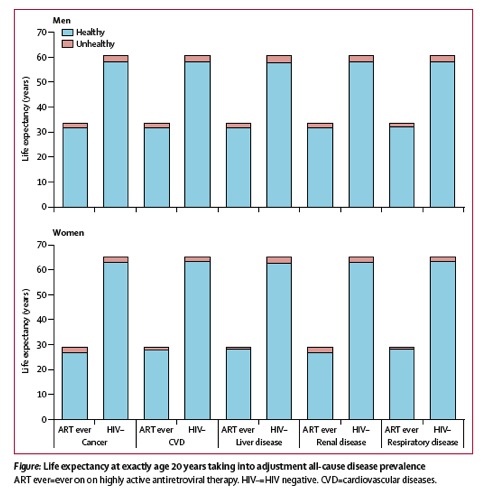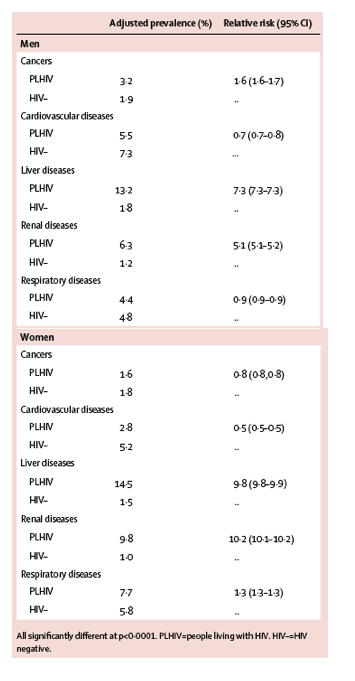| |
AGING CRISIS: Comorbidities Shorten Life & HALE:
Healthy Years of Life Expectancy
|
| |
| |
from Jules: this study demonstrates the differences comorbidities make on life expectancy AND HALE, which is the "number of healthy years one is expected to live by subtracting years of ill health from overall life expectancy". This study demonstrates the impact of comorbidities in HIV+ vs HIV-neg on life expectancy. The study is on population in British Columbia where IDU is common & this affects outcome but many in the US also have a history of substance abuse & IDU so these results have application in the USA. HIV+ have half the HALE vs HIV-neg & HIV+ women have 12% worsen vs HIV+ men HALE.....In this study but also in the USA HIV+ men & women have high rates of renal & liver diseases reflected from a history of IDU. In the USA many without a history of IDU also have higher rates of cardiovascular disease, renal disease, liver disease, bone disease & cancers, all of which are associated with greater cognitive impairment & frailty, combine all this together & you have the AGING CRISIS, which remains unaddressed.
"Expanded service delivery interventions to address complex care needs of ageing PLHIV are crucial to address shorter life expectancies, and improve their healthy states."
HALE: "At exactly age 20 years, HALE was about 31 years (SD 0 16) among men living with HIV and 27 years (0 16) among women living with HIV. In the HIV-negative population, HALE was around 58 years (SD 0 02) for men and 63 years (0 02) for women.....AmongPLHIV, women had a significantly lower life expectancy at this exact age than men (29⋅1 years [SE 0⋅1] vs 33⋅7 years [0⋅1]; p<0⋅001)."
insight into how a substantially higher burden of comorbidity can directly affect the health life expectancy of PLHIV compared with their HIV-negative counterparts......this study is the first to characterise the length of the health state for both PLHIV and HIV-negative individuals, and show differences in shortened life expectancy among women and men living with HIV.
Comorbidities & Life Expectancy: the affect of comorbidities on Life Expectancy- (03/15/17)

HALE: [Health-Adjusted Life Expectancy] number of Healthy Years Expected To Live by Subtracting the Years of Ill Health from Overall Life Expectancy......"PLHIV-especially women living with HIV-spent less time in a healthy state.....Expanded service delivery interventions to address complex care needs of ageing PLHIV are crucial to address shorter life expectancies, and improve their healthy states."
In conclusion, our results show that PLHIV spend proportionally about the same amount of time in a healthy state as their HIV-negative counterparts in British Columbia. However, PLHIV, especially women, have much shorter overall life expectancies than their HIV-negative general population counterparts, and thus spend notably less time in a healthy state. Because life expectancy for many PLHIV is increasingly comparable to HIV-negative populations,22 we show here that it remains imperative to address the challenges this population faces in achieving a healthy state to improve quality of life over the life course.
"We sought to understand whether people living with HIV (PLHIV) ever on highly active antiretroviral therapy (ART) follow a pattern where morbidity is compressed into the last years of life or lessened as people age. We aimed to estimate health-adjusted life expectancy (HALE) among adults living with and without HIV, and examine dependency between causes of comorbidities. our results show that PLHIV spend proportionally about the same amount of time in a healthy state as their HIV-negative counterparts in British Columbia. However, PLHIV,especially women,have much shorter overall life expectancies than their HIV-negative general population counterparts, and thusspend notably less time in a healthy state. Because life expectancy for many PLHIV is increasingly comparable to HIV-negative populations,22 we show here that it remains imperative to address the challenges this population faces in achieving a healthy state to improve quality of life over the life course......The primary outcome variable in our analysis was HALE.This measure estimates the number of healthy years an individual is expected to live at birth by subtracting the years of ill health from overall life expectancy.4 In addition to HALE, we estimated the prevalence of five comorbidities, which were used to estimate HALE. Because of their prevalence among PLHIV, we considered cardiovascular, respiratory, liver, and renal diseases, and non-AIDS defining cancers.....49 605 deaths and 5576 841 person-years were accumulated during this study. 21% (1958 of 9310) of PLHIV ever on ART died compared with 9% (47 647 of 510 313) in the uninfected cohort. Life expectancy at exact age 20 years between those ever on ART and those uninfected was 33 7 years (SE 0 1) versus 60 5 years (0 1) for men and 29 1 years (0 1) versus 65 4 years (0 1) for women. Among PLHIV, women had a significantly lower life expectancy at this exact age than men (29 1 years [SE 0 1] vs 33 7 years [0 1]; p<0 001).....Rates of mortality, crude and directly adjusted to the Canadian population, were significantly higher among both men and women living with HIV (table 2). Men and women living with HIV had high prevalences of renal and liver diseases compared with those in HIV-negative counterparts.
"We aimed to estimate health-adjusted life expectancy (HALE) among adults living with and without HIV, and examine dependency between causes of comorbidities......Men and women living with HIV had high prevalences of renal and liver diseases compared with those in HIV-negative counterparts......we add to the literature by integrating HALE measures to generate insight into how a substantially higher burden of comorbidity can directly affect the health life expectancy of PLHIV compared with their HIV-negative counterparts.....At exactly age 20 years, HALE was about 31 years (SD 0 16) among men living with HIV and 27 years (0 16) among women living with HIV. In the HIV-negative population, HALE was around 58 years (SD 0 02) for men and 63 years (0 02) for women. These results seem independent of ordering. However, PLHIV, particularly women living with HIV, had much shorter overall life expectancies than did their HIV-negative counterparts in the general population [29 1 years (SD 0 1)vs65 4 years (0 1)], and thus spent less time in a healthy state."

|
|
| |
| |
|
|
|